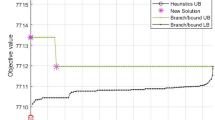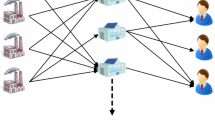Abstract
Efficient and effective production planning and supplier selection are important decisions for manufacturing industries in a highly competitive supply chain, in particular, when customers are willing to accept products with less desirable product attributes (e.g., color, material) for economic reasons. Yet these two decision making problems have traditionally been studied separately due to their inherent complexity. This paper attempts to solve optimally the challenging joint optimization problem of production planning and supplier selection, considering customer flexibility for a manufacturer producing multiple products to satisfy customers’ demands. This integrated problem has been formulated as a new mixed integer programming model. The objective is to maximize the manufacturer’s total profit subject to various operating constraints of the supply chain. Due to the complexity and non-deterministic polynomial-time (NP)-hard nature of the problem, an improved genetic approach is proposed to locate near-optimal solutions. This approach differs from a canonical genetic algorithm in three aspects, i.e., a new selection method to reduce the chance of premature convergence and two problem-specific repair heuristics to guarantee the feasibility of the solutions. The computational results of applying the proposed approach to solve a set of randomly generated test problems clearly demonstrate its excellent performance.













Similar content being viewed by others
References
Balakrishnan, N., & Chakravarty, A. K. (2008). Product design with multiple suppliers for component variants. International Journal of Production Economics, 112(2), 723–741.
Butler, J. C., Dyer, J. S., Jia, J., & Tomak, K. (2007). Enabling e-transactions with multi-attribute preference models. European Journal of Operational Research, 186(2), 748–765.
Cakravastia, A., & Takshashi, K. (2004). Integrated model for supplier selection and negotiation in a make-to-order environment. International Journal of Production Research, 42(21), 4457–4474.
Carrera, D. A., & Mayorga, R. V. (2008). Supply chain management: A modular fuzzy inference system approach in supplier selection for new product development. Journal of Intelligent Manufacturing, 19(1), 1–12.
Charnsirisakskul, K., Griffin, P., & Keskinocak, P. (2006). Pricing and scheduling decisions with leadtime flexibility. European Journal of Operational Research, 171, 153–190.
Che, Z. H., & Wang, H. S. (2008). Supplier selection and supply quantity allocation of common and non common parts with multiple criteria under multiple products. Computers and Industrial Engineering, 55, 110–133.
Cheshmehgaz, H. R., Desa, M. I., & Wibowo, A. (2013). A flexible three-level logistic network design considering cost and time criteria with a multi-objective evolutionary algorithm. Journal of Intelligent Manufacturing, 24(2), 277–293.
De Boer, L., Labro, E., & Morlacchi, P. (2001). A review of methods supporting supplier selection. European Journal of Purchasing and Supply Management, 7, 75–89.
Faez, F., Ghodsypour, S. H., & Brien, C. O. (2009). Vendor selection and order allocation using an integrated fuzzy case-based reasoning and mathematical programming model. International Journal of Production Economics, 121(2), 395–408.
Fernandes, R., Gouveia, J. B., & Pinho, C. (2012). Product mix strategy and manufacturing flexibility. Journal of Manufacturing Flexibility, 31(3), 301–311.
Ghodsypour, S., & O’Brien, C. (2001). The total cost of logistics in supplier selection, under conditions of multiple sourcing, multiple criteria and capacity constraint. International Journal of Production Economics, 73, 15–27.
Goldberg, D. E. (1989). Genetic algorithms in search, optimization, and machine learning. Reading, MA: Addison-Wesley.
Gosselin, L., Tye-Gingras, M., & Mathieu-Potvin, F. (2009). Review of utilization of genetic algorithms in heat transfer problems. International Journal of Heat and Mass Transfer, 52, 2169–2188.
Green, P. E., & Srinivasan, V. (1990). Conjoint analysis in marketing: New developments with implications for research and practice. Journal of Marketing, 54(4), 3–19.
Hasuike, T., & Ishii, H. (2009). On flexible product-mix decision problems under randomness and fuzziness. Omega, 37(4), 770–787.
Hodge, B. M., Pettersson, F., & Chakraborti, N. (2006). Re-evaluation of the optimal operating conditions for the primary end of an integrated steel plant using multi-objective genetic algorithms and Nash equilibrium. Steel Research International, 77, 459–461.
Holland, J. H. (1975). Adaptation in natural and artificial system: An introductory analysis with applications to biology, control, and artificial intelligence. Ann Arbor, MI: University of Michigan Press.
Jawahar, N., & Balaji, A. N. (2009). A genetic algorithm for the two-stage supply chain distribution problem associated with a fixed charge. European Journal of Operational Research, 194, 496–537.
Jiao, J., Tseng, M. M., Ma, Q., & Zou, Y. (2000). Generic bill-of-materials-and-operations for high-variety production management. Concurrent Engineering: Research and Applications, 8, 297–321.
Kaya, M. (2011a). The effects of two new crossover operators on genetic algorithm performance. Applied Soft Computing, 11(1), 881–890.
Kaya, M. (2011b). The effects of a new selection operator on the performance of a genetic algorithm. Applied Mathematics and Computation, 217(19), 7669–7678.
Kim, B., Leung, J. M. Y., Park, K. T., Zang, G., & Lee, S. (2002). Configuring a manufacturing firm’s supply network with multiple suppliers. IIE Transactions, 34, 663–677.
Lamothe, J., Hadj-Hamou, K., & Aldanondo, M. (2006). An optimization model for selecting a product family and designing its supply chain. European Journal of Operation Research, 169, 1030–1047.
Liu, B. (2002). Theory and practice of uncertain programming. Heidelberg, Germany: Physica-Verlag.
Mak, K. L., Wong, Y. S., & Chan, F. T. S. (1998). A genetic algorithm for facility layout problems. Computer Integrated Manufacturing Systems, 11, 113–127.
Mak, K. L., Wong, Y. S., & Wang, X. X. (2000). An adaptive genetic algorithm for manufacturing cell formation. The International Journal of Advanced Manufacturing Technology, 16, 491–497.
Meena, P. L., & Sarmah, S. P. (2013). Multiple sourcing under supplier failure risk and quantity discount: A genetic algorithm approach. Transportation Research Part E: Logistics and Transportation Review, 50(2), 84–97.
Michalewicz, Z. (1996). Genetic Algorithms + Data Structures = Evolution Programs. New York, NY: Springer.
Murthi, B. P. S., & Sarkar, S. (2003). The role of the management sciences in research on personalization. Management Science, 49(10), 1344–1362.
Pang, B., & Bai, S. Z. (2013). An integrated fuzzy synthetic evaluation approach for supplier selection based on analytic network process. Journal of Intelligent Manufacturing, 24(1), 163–174.
Pine, B. J., Victor, B., & Boynton, A. C. (1993). Making mass customization work. Harvard Business Review, 71, 108–119.
Rajaram, K., & Tang, C. S. (2001). The impact of product substitution on retail merchandising. European Journal of Operational Research, 135(3), 582–601.
Rezaei, J., & Davoodi, M. (2008). A deterministic, multi-item inventory model with supplier selection and imperfect quality. Applied Mathematical Modeling, 32(10), 2106–2116.
Salehi, M., & Tavakkoli-Moghaddam, R. (2009). Application of genetic algorithm to computer-aided process planning in preliminary and detailed planning. Engineering Applications of Artificial Intelligence, 22, 1179–1187.
Seifbarghy, M., & Esfandiari, N. (2013). Modeling and solving a multi-objective supplier quota allocation problem considering transaction costs. Journal of Intelligent Manufacturing, 24(1), 201–209.
Sharma, S., & Balan, S. (2013). An integrative supplier selection model using Taguchi loss function TOPSIS and multi criteria goal programming. Journal of Intelligent Manufacturing, 24(6), 1123–1130.
Singh, S. P., & Sharma, R. R. K. (2006). A review of different approaches to the facility layout problems. The International Journal of Advanced Manufacturing Technology, 30, 425–433.
Smeltzer, L. R. (1997). The meaning and origin of trust in buyer–supplier relationships. Journal of Supply Chain Management, 33, 40–48.
Tang, C., & Yin, R. (2007). Joint ordering and pricing strategies for managing substitutable products. Production and Operations Management, 16(1), 139–153.
Tseng, M. M., & Jiao, J. (1996). Design for mass customization. CIRP Annals, 45(1), 153–156.
Urban, T. L., & Baker, R. C. (1997). Optimal ordering and pricing policies in a single-period environment with multivariate demand and markdowns. European Journal of Operational Research, 103(3), 573–583.
Wang, H. S. (2008). Configuration change assessment: Genetic optimization approach with fuzzy multiple criteria for part supplier selection decisions. Expert Systems with Applications, 34(2), 1541–1555.
Weber, C. A., & Current, J. R. (1993). A multi-objective approach to vendor selection. European Journal of Operational Research, 68, 173–184.
Yoo, D., & Ohta, H. (1995). Optimal pricing and product-planning for new multi-attribute products based on conjoint analysis. International Journal of Production Economics, 38(2–3), 245–253.
Zhang, X. Y., & Huang, G. Q. (2010). Game-theoretic approach to simultaneous configuration of platform products and supply chains with one manufacturing firm and multiple cooperative suppliers. International Journal of Production Economics, 124(1), 121–136.
Zhu, B., Wang, Z., Yang, H. C., Mo, R., & Zhao, Y. W. (2008). Applying fuzzy multiple attributes decision making for product configuration. Journal of Intelligent Manufacturing, 19, 591–598.
Acknowledgments
This research was supported by the National Natural Science Foundation of China (No. 61272398).
Author information
Authors and Affiliations
Corresponding author
Rights and permissions
About this article
Cite this article
Cui, L.X. Joint optimization of production planning and supplier selection incorporating customer flexibility: an improved genetic approach. J Intell Manuf 27, 1017–1035 (2016). https://doi.org/10.1007/s10845-014-0932-5
Received:
Accepted:
Published:
Issue Date:
DOI: https://doi.org/10.1007/s10845-014-0932-5




